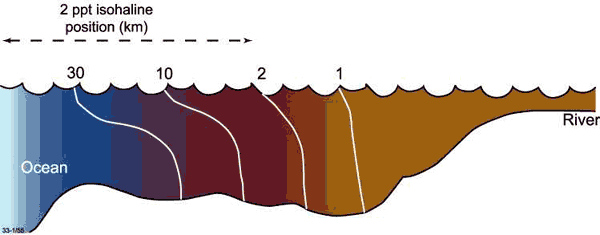What does isohaline position refer to?
Isohalines are lines (or contours) that join points of equal salinity in an aquatic system. Isohaline position refers to the distance (kilometres) of a near-bottom isohaline (usually 2 ppt) from the mouth of a coastal waterway (Figure 1).

Figure 1. Schematic illustration showing the 30, 10, 2 and 1 ppt isohalines in vertical section and how the 2 ppt isohaline position is measured.
Significance of the 2 ppt isohaline position
In the San Francisco Estuary, the 2 ppt near-bottom isohaline (X2):
- is a useful length scale for parameterising the spatial structure of a salt field1;
- is statistically related to important base-components of food-webs (i.e. the amount of phytoplankton and particulate organic carbon)1;
- is related to the abundance of zooplankton consumers and benthic macroinvertebrates, and to the abundance and survival of planktivorous, piscivorous & demersal fish assemblages1;
- separates the upstream reaches of the estuary, characterised by weak pressure gradients and little or no stratification, from the downstream reaches of the estuary characterised by strong baroclinic pressure gradients and density stratification1; and
- often occurs near the location of the turbidity maximum1.
Significance of the 2 ppt isohaline position in Australian coastal waters?
Although the 2 ppt isohaline has not been trialled as a habitat indicator in Australian coastal waterways, it is highly likely that isohalines in the range from 1 – 5 ppt also have physical and ecological meaning here. This is because important changes in the ionic structure of water occur in the salinity range from 1 – 5 ppt in a seawater-meteoric water mixing system, and there is evidence that these changes influence the species of crustaceans found in salt lakes2. These changes, which may also affect the species composition of estuarine organisms, include:
- the onset of calcium carbonate precipitation, causing abrupt changes in Ca/alkalinity and alkalinity/Cl ratios2; and
- increased involvement of sodium ions in neutral ion pairs2.
What causes isohaline position to change?
The position of near-bottom isohalines change in response to the amount of freshwater inflow and thus can be used as a guide to policy makers and managers for setting environmental flow standards1.
Coastal waterways to which this indicator applies
Isohaline position probably has widespread application as a habitat indicator in coastal waterways1.
Considerations for measurement and interpretation
Salinity distribution should be monitored continuously from at least six stations spaced roughly 5 km apart1.
Although the 2 ppt isohaline position is a good indicator of an estuarine communities response to net freshwater flow, other hydraulic features can have effects on resource levels and population abundances that are independent of X2.
More information on freshwater flow regime (changed from natural); excess freshwater and excess salt.
Contributors
Lynda Radke, Geoscience Australia
- Jassby, A.D., Kimmerer, W.J., Monismith, S.G., Armor, C., Powell, T.M., Schubel, J.R., and Vendlinski, T.J. 1995. Isohaline position as a habitat indicator for estuarine populations. Ecological Applications 5(1), 272-289. ↩ ↩ ↩ ↩ ↩ ↩ ↩ ↩
- Radke, L.C., Juggins, S., Halse, S.A., De Deckker, P., and Finston, T. Chemical diversity in south-eastern Australian saline lakes II: biotic implications. Marine and Freshwater Research. In submission. ↩ ↩ ↩


